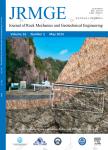Multi-scale modelling of gas flow in nanoscale pore space with fractures
Multi-scale modelling of gas flow in nanoscale pore space with fractures作者机构:Research Centre for Radwaste&Decommissioning and Modelling&Simulation CentreDalton Nuclear InstituteUniversity of ManchesterManchesterM139PLUK School of MechanicalAerospace and Civil EngineeringUniversity of ManchesterManchesterM139PLUK State Key Laboratory of Geomechanics and Geotechnical EngineeringInstitute of Rock and Soil MechanicsChinese Academy of SciencesWuhan430071China University of Chinese Academy of SciencesBeijing100049China
出 版 物:《Journal of Rock Mechanics and Geotechnical Engineering》 (岩石力学与岩土工程学报(英文版))
年 卷 期:2020年第12卷第1期
页 面:32-40页
核心收录:
学科分类:081803[工学-地质工程] 08[工学] 0818[工学-地质资源与地质工程] 0815[工学-水利工程] 0813[工学-建筑学] 0814[工学-土木工程]
基 金:the support of the National Natural Science Foundation of China(Grant Nos.41572290,51879260 and 51879258) CAS Interdisciplinary Innovation Team(JCTD-2018-17)
主 题:Pore network Nanopores Apparent gas permeability Callovo-Oxfordian(COx)claystone
摘 要:In this work,a multi-scale pore network with fractures is developed against experimental data in a wide range of degrees of water *** pore network is constructed based on the measured microstructure information at several length *** gas transport is predicted by different gas transport equations(***,dusty gas model(DGM),Civan and Klinkenberg),which can consider the fundamental physics mechanisms in tight porous media,such as Knudsen diffusion and viscous ***,the model is applied to simulating the gas permeability of the Callovo-Oxfordian(COx)*** predicted gas permeability is basically in good agreement with the experimental data under different degrees of water *** the effects of micro-fissures are *** results suggest that this model can predict the gas flow in other tight porous media as well and can be applied to other fields such as carbon capture and storage.



